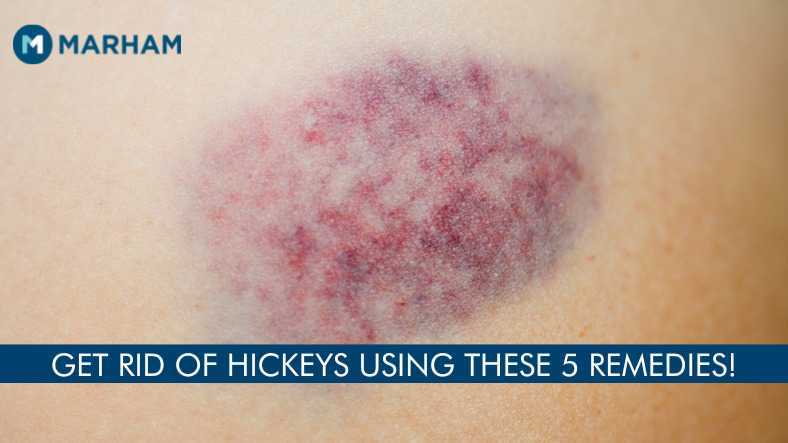Have you ever woken up with a mysterious mark on your neck or arm? Was it a passionate encounter or simply an awkward encounter with a door? The age-old question arises: is it a hickey or a bruise? Unraveling this mystery can reveal more than just the source of the mark. It can provide insight into your recent activities and even offer a glimpse into your health.

Image: www.marham.pk
Whether you’re curious about the science behind these marks, worried about how to treat them, or just seeking to decipher the truth behind a strange mark, this article is your guide. We’ll delve into the fascinating world of hickies and bruises, exploring their causes, characteristics, and treatments. We’ll also address the social stigma surrounding hickies and provide tips for managing the sometimes embarrassing reality of these marks.
Understanding the Basics: What are Hickies and Bruises?
Hickies and bruises are both forms of skin discoloration caused by trauma to the blood vessels underneath the skin. However, their underlying causes and appearances differ significantly.
Hickies, also known as love bites, are caused by suction on the skin, typically from passionate kissing or oral stimulation. The suction results in blood vessels breaking and leaking blood into the surrounding tissues. This leaked blood creates the distinctive red or purple mark we recognize as a hickey.
Bruises, in contrast, are caused by blunt force trauma to the body such as a fall, bump, or hit. This trauma ruptures blood vessels, causing bleeding into the surrounding tissues. These bruises can range in color from red to purple to blue to yellow as the body reabsorbs the leaked blood.
The Telltale Signs: How to Differentiate Between a Hickey and a Bruise
Differentiating between a hickey and a bruise can be tricky, but certain key features can help you make the distinction:
- Location: Hickies are most commonly found on the neck, shoulders, chest, or arms – areas typically accessible during passionate kissing. Bruises can occur anywhere on the body, depending on the source of the trauma.
- Shape: Hickies tend to have a circular or oval shape, reflecting the suction force that caused them. Bruises, on the other hand, can have various shapes and sizes, reflecting the impact that caused them.
- Color: While both hickies and bruises can be purple or red, hickies often have a more intense, concentrated color, whereas bruises tend to have a more dispersed, faded appearance.
- Elevation: Hickies are often slightly raised or lumpy, reflecting the blood pooling under the skin. Bruises, while they may be slightly raised initially, usually flatten out as they heal.
The Healing Process: How Long Do Hickies and Bruises Last?
The healing time for both hickies and bruises varies depending on the severity of the damage. Generally, a hickey can last anywhere from a few days to a week or two, while a bruise can take anywhere from a few days to a few weeks to heal completely.
- Hickey Healing: The discoloration fades as the body reabsorbs the leaked blood. Applying a cold compress or ice pack to the area can help reduce swelling and speed up healing.
- Bruise Healing: Over time, the color of a bruise will change from purple to blue to green to yellow as the body breaks down the leaked blood. Cold compresses and elevating the bruised area can help minimize swelling and pain.

Image: ncsmpg.blogspot.com
Social Stigma and Managing the Embarrassment of a Hickey
Hickies come with a certain social stigma, often associated with romantic encounters. This can lead to feelings of embarrassment or awkwardness, especially if you’re trying to conceal the mark.
- Managing the Embarrassment: If you’re worried about a hickey being visible, try to cover it with clothing or makeup. If you’re unable to cover it up, try to laugh it off or address it head-on with a lighthearted explanation, for example, “Oh, I had a long day and must have leaned on something in the wrong way.”
Expert Insights: Tips for Preventing and Managing Hickies and Bruises
Here are a few expert-approved tips to help prevent and manage these marks:
- Preventing Hickies: Practice safe kissing techniques. Avoid excessive suction or biting during kissing.
- Preventing Bruises: Be mindful of your surroundings and take precautions against falls or bumps. Wear protective gear during activities that pose a risk of bruising.
- Treating Hickies and Bruises: For both hickies and bruises, cold compresses, elevation, and over-the-counter pain relievers can help manage pain and speed up healing.
Beyond the Basics: When to See a Doctor
While most hickies and bruises heal on their own, it’s important to see a doctor if you experience any of the following:
- Severe pain or swelling.
- A mark that is large, spreading, or changing color.
- A mark that doesn’t improve after a few days.
- Fever or chills.
Hickey Or Bruise
Conclusion
The next time you notice a mysterious mark on your skin, remember that it could be a hickey, a bruise, or something else entirely. Understanding the differences between these marks, as well as how to manage their appearance and healing process, can help you navigate these situations with greater confidence and knowledge. Remember, most hickies and bruises are temporary and harmless. However, if you have any concerns, don’t hesitate to seek medical advice.





